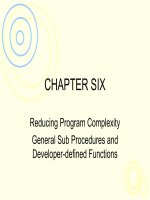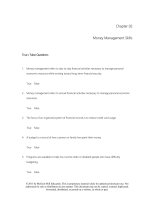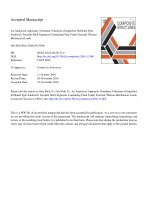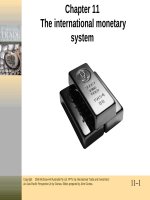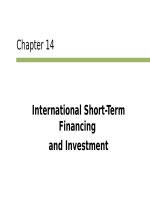Lecture International finance: An analytical approach (3/e): Chapter 6 - Imad A. Moosa
Bạn đang xem bản rút gọn của tài liệu. Xem và tải ngay bản đầy đủ của tài liệu tại đây (224.05 KB, 31 trang )
Chapter 6
The Eurocurrency Market and
International Banking
Objectives
• To define the Eurocurrency market
• To identify Eurocurrencies and Eurocurrency banking
centres
• To identify reasons for the growth of the
Eurocurrency market
(cont.)
Copyright 2010 McGraw-Hill Australia Pty Ltd
PPTs t/a International Finance: An Analytical Approach 3e by Imad A. Moosa
Slides prepared by Afaf Moosa
6-2
Objectives (cont.)
• To identify the main features of Eurobanking
• To illustrate the determination of the bid-offer spread
and the risk premium in Eurocurrency deposit rates
• To describe international banking
Copyright 2010 McGraw-Hill Australia Pty Ltd
PPTs t/a International Finance: An Analytical Approach 3e by Imad A. Moosa
Slides prepared by Afaf Moosa
6-3
The Eurocurrency market
• The market is comprised of banks that accept shortterm deposits and make short-term loans in
currencies other than that of the country in which
they are located
Copyright 2010 McGraw-Hill Australia Pty Ltd
PPTs t/a International Finance: An Analytical Approach 3e by Imad A. Moosa
Slides prepared by Afaf Moosa
6-4
Eurocurrencies
•
•
•
•
•
US dollar
Euro
Japanese yen
British pound
Swiss franc
Copyright 2010 McGraw-Hill Australia Pty Ltd
PPTs t/a International Finance: An Analytical Approach 3e by Imad A. Moosa
Slides prepared by Afaf Moosa
6-5
Prerequisites for Eurocurrency
centres
•
•
•
•
•
Political stability
Favourable environment for international finance
Good telecommunications system
Favourable time zone
High quality of life
Copyright 2010 McGraw-Hill Australia Pty Ltd
PPTs t/a International Finance: An Analytical Approach 3e by Imad A. Moosa
Slides prepared by Afaf Moosa
6-6
Eurocurrency centres
• European centres: London, Luxembourg, Paris,
Zurich and Frankfurt
• Centres outside developed countries: the Bahamas,
Dubai and Hong Kong
• North America and Japan: International Banking
Facilities (IBFs) and the Japan Offshore Market
(JOM)
Copyright 2010 McGraw-Hill Australia Pty Ltd
PPTs t/a International Finance: An Analytical Approach 3e by Imad A. Moosa
Slides prepared by Afaf Moosa
6-7
Evolution and growth
• The market started in the 1950s.
• In 1957, the Bank of England introduced tight
controls
• In 1958, European currencies were made convertible
(cont.)
Copyright 2010 McGraw-Hill Australia Pty Ltd
PPTs t/a International Finance: An Analytical Approach 3e by Imad A. Moosa
Slides prepared by Afaf Moosa
6-8
Evolution and growth (cont.)
• The rise of oil prices in the 1970s produced huge
financial surpluses for oil-exporting countries. These
surpluses were deposited at Eurobanks
(cont.)
Copyright 2010 McGraw-Hill Australia Pty Ltd
PPTs t/a International Finance: An Analytical Approach 3e by Imad A. Moosa
Slides prepared by Afaf Moosa
6-9
Evolution and growth (cont.)
• Eurobanks are efficient because:
they are not subject to regulations, such as Regulation Q,
interest equalisation tax
no reserve requirements
economies of scale
Copyright 2010 McGraw-Hill Australia Pty Ltd
PPTs t/a International Finance: An Analytical Approach 3e by Imad A. Moosa
Slides prepared by Afaf Moosa
6-10
Features of Eurobanking
• International banking encompasses Eurobanking
• Liabilities are time or call deposits
• Eurobanks cannot create deposits by writing claims
against themselves
(cont.)
Copyright 2010 McGraw-Hill Australia Pty Ltd
PPTs t/a International Finance: An Analytical Approach 3e by Imad A. Moosa
Slides prepared by Afaf Moosa
6-11
Features of Eurobanking (cont.)
• Eurobanks accept deposits and make loans in a
variety of currencies
• A Eurobank is often a branch of an international bank
• There are no formal restrictions on entry
(cont.)
Copyright 2010 McGraw-Hill Australia Pty Ltd
PPTs t/a International Finance: An Analytical Approach 3e by Imad A. Moosa
Slides prepared by Afaf Moosa
6-12
Features of Eurobanking (cont.)
• Transactions are large
• The geographical spread is very wide
• The market is not subject to the regulatory measures
of the local authorities
(cont.)
Copyright 2010 McGraw-Hill Australia Pty Ltd
PPTs t/a International Finance: An Analytical Approach 3e by Imad A. Moosa
Slides prepared by Afaf Moosa
6-13
Features of Eurobanking (cont.)
• The market is dominated by interbank operations
• Participants include multinationals and central banks
• Eurobanks do not have to hold reserves against
deposits
Copyright 2010 McGraw-Hill Australia Pty Ltd
PPTs t/a International Finance: An Analytical Approach 3e by Imad A. Moosa
Slides prepared by Afaf Moosa
6-14
Determination of the bid-offer
spread in interest rates
• The bid rate is determined by the demand by market
makers and the supply of price takers
• The offer rate is determined by the demand by price
takers and the supply of market makers
Copyright 2010 McGraw-Hill Australia Pty Ltd
PPTs t/a International Finance: An Analytical Approach 3e by Imad A. Moosa
Slides prepared by Afaf Moosa
6-15
Interest rate determination
i
S
M
DT
ia
S
T
ib
Q
DM
Copyright 2010 McGraw-Hill Australia Pty Ltd
PPTs t/a International Finance: An Analytical Approach 3e by Imad A. Moosa
Slides prepared by Afaf Moosa
Q
6-16
The risk premium
• Only borrowers of high quality can borrow at the offer
rate quoted by market makers
• Others have to pay a risk premium
Copyright 2010 McGraw-Hill Australia Pty Ltd
PPTs t/a International Finance: An Analytical Approach 3e by Imad A. Moosa
Slides prepared by Afaf Moosa
6-17
Risk premium associated with lowquality borrowers
i
S
ia
M
ρ
ia
ρ
DL
DH
Q
Copyright 2010 McGraw-Hill Australia Pty Ltd
PPTs t/a International Finance: An Analytical Approach 3e by Imad A. Moosa
Slides prepared by Afaf Moosa
6-18
International banking
• International banking operations encompass those
conducted with non-residents as well as those
involving foreign currencies
Copyright 2010 McGraw-Hill Australia Pty Ltd
PPTs t/a International Finance: An Analytical Approach 3e by Imad A. Moosa
Slides prepared by Afaf Moosa
6-19
Reasons for the emergence of
international banking
•
•
•
•
Meeting the needs of foreign subsidiaries
Participation in the FX market
Circumventing capital controls
Provision of custodial services
Copyright 2010 McGraw-Hill Australia Pty Ltd
PPTs t/a International Finance: An Analytical Approach 3e by Imad A. Moosa
Slides prepared by Afaf Moosa
6-20
Traditional activities
• Export-import finance
• Buying and selling foreign exchange
• Provision of foreign loans
Copyright 2010 McGraw-Hill Australia Pty Ltd
PPTs t/a International Finance: An Analytical Approach 3e by Imad A. Moosa
Slides prepared by Afaf Moosa
6-21
New activities
• Dealing in Eurocurrencies
• Syndicated Eurocredit
• Investment banking
Copyright 2010 McGraw-Hill Australia Pty Ltd
PPTs t/a International Finance: An Analytical Approach 3e by Imad A. Moosa
Slides prepared by Afaf Moosa
6-22
Innovative activities
•
•
•
•
Innovative financing
Global money market
Managing the loan portfolios of developing countries
Private banking
Copyright 2010 McGraw-Hill Australia Pty Ltd
PPTs t/a International Finance: An Analytical Approach 3e by Imad A. Moosa
Slides prepared by Afaf Moosa
6-23
The organisational set-up
•
•
•
•
•
•
Correspondent banks
Representative offices
Bank agencies
Foreign branches, subsidiaries and affiliates
Consortium banks
Global banks
Copyright 2010 McGraw-Hill Australia Pty Ltd
PPTs t/a International Finance: An Analytical Approach 3e by Imad A. Moosa
Slides prepared by Afaf Moosa
6-24
Correspondent banks
• When a bank has no branch in a particular country it
uses a foreign bank located in that country to settle
transactions on its behalf
Copyright 2010 McGraw-Hill Australia Pty Ltd
PPTs t/a International Finance: An Analytical Approach 3e by Imad A. Moosa
Slides prepared by Afaf Moosa
6-25

